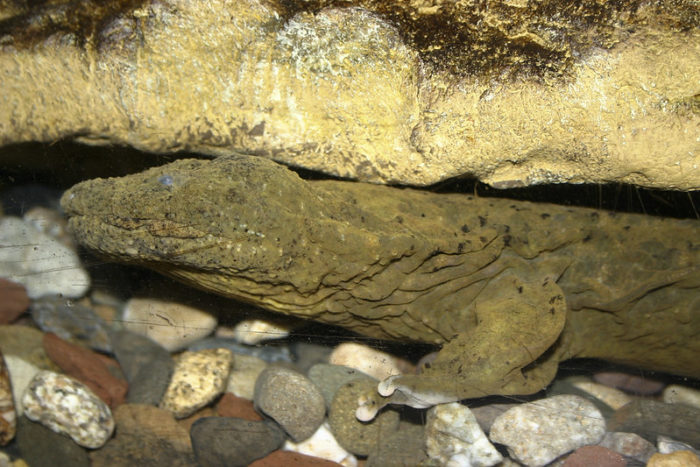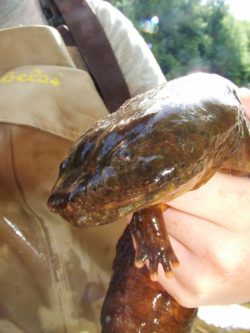
Sea Wonder: Hellbender Salamander

Photo credit: Brian Gratwicke
Hellbender salamanders (Cryptobranchus alleganiensis) have existed for about 150 million years and are the largest species of salamander in all of North America. While their scientific name means “hidden gills”, they are affectionately nicknamed snot otters, devil dogs, and mudcats.
Description
Adult hellbenders are between 12 and 29 inches long and weigh up to five pounds. Generally, males are larger than females. They are fully aquatic amphibians, which influences their physiology. They have flat heads, small eyes, and wrinkled skin all over their bodies. At the end of their bodies are paddle-shaped tails, which are useful for navigating their flowing stream habitats. They are grayish to olive brown in color and sport irregular dark spots along their backs. They have a pair of large lungs for their body size, which they use for buoyancy rather than breathing. Juveniles have true gills, which disappear in adulthood, leaving behind open gill slits, though hellbender salamanders exchange oxygen through their skin.
Diet and Habitat
Hellbender salamanders are carnivorous, feeding most often on crayfish. They will also hunt small fish and invertebrates, other hellbenders, tadpoles, toads, and water snakes. They are nocturnal feeders, using the cover of nightfall to sneak up on and capture unsuspecting prey.
Hellbenders typically live under large rocks, boulders, or logs, where they dig small burrows for themselves. They generally spend daylight hours resting in their burrows and are more active at night. Very rarely do they spend time out of the water. The species’ range spans throughout the Appalachian region, including rivers, streams, and estuaries in Kentucky, Ohio, Indiana, Illinois, and Missouri. They are also found along the east coast from southern New York down to northern Georgia.
Life History
Hellbender salamanders remain active throughout the year, but do slow down considerably in the colder months. The late summer marks the beginning of courtship behavior and reproduction, with the peak of breeding activity taking place in the autumn months. Females are attracted or corralled to nest sites by males, where they lay two long strings of 200 to 400 eggs that attach to fixed structures like rocks or logs. Males fertilize the eggs and drive females out of the nest, leaving males responsible for guarding the nest and eggs until they hatch, which occurs about 60 days after fertilization.
When the eggs hatch, larvae are about an inch long with disproportionately large external gills. They reach their juvenile life stage within a few months, and continue growing until they reach adulthood at about five to seven years old. As they grow, their gills disappear and the salamanders breathe through their skin.
Hellbender salamanders can live as long as 25 years in their habitats, but have lived longer under human care.
Threats and Conservation
Juvenile hellbenders have many predators, including fish, turtles, water snakes, and larger hellbenders. Adult hellbenders have few predators, though they are occasionally eaten by raccoons, minks, and river otters.
The hellbender salamander is listed as Near Threatened by the IUCN and is close to qualifying for a downgraded Vulnerable status. Population decreases are primarily due to habitat loss and degradation associated with human development. Most places are uphill from the ocean, and you can help protect hellbenders and other freshwater critters by using fewer pesticides and fertilizers at home, keeping storm drains free from litter, and recreating responsibly in freshwater ecosystems.

Photo credit: D. Kazyak
